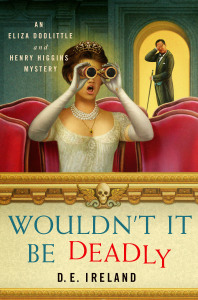by D.E. Ireland, @DEIrelandAuthor 
If you’ve come with up a unique idea for a book, congratulations. But you may need advice on how to shepherd this idea from that first inspiration to typing the last line of your final draft. Here are six steps that can help you along the way.
- First you need a light bulb moment. An idea pops in your brain, you say, “what if…?” and off you go to develop the premise. It’s perhaps the most exciting part of writing. Then reality sets in. We came up with the novel idea of Eliza Doolittle solving mysteries with Henry Higgins. But we first had to ascertain whether Shaw’s characters were in the public domain (yes, thankfully) and steer clear of Lerner & Loewe’s film My Fair Lady, which isn’t.
- Write down that premise before the idea floats away. Otherwise another writer will eventually pluck it out of the ethereal domain and make it their own. Discuss it to death if you have a writing or critique partner. Is it workable, or the stupidest thing you’ve ever come up with in your career? Writing hours are precious, so don’t waste time on an idea that will end up going nowhere. We knew Eliza and Higgins would be an entertaining pair of amateur sleuths, and that London in 1913 would make it even better. We just needed a plot, murder victims, red herrings, clues, and suspects. Oh, and a killer with a motive.
- Expand the premise into a paragraph or a page. Let your creative juices flow. If you aren’t in a writing team, find someone who can act as a sounding board. Not your children, your mother, or your spouse. You don’t need a yes-man, you need another writer who understands the process of fleshing out a story. We (the first time working as D.E. Ireland) spent days going over story possibilities, and then another few weeks reading and rereading G.B. Shaw’s Pygmalion along with countless hours researching Edwardian London.
- After a month or two of brainstorming, you should be ready to outline. We’ve both written books by the seat of our pants and it can be an exhilarating process. Other times, it feels like you’re driving across the country without a map or highway signs to give you any direction. And you may end up in a roadside pit of despair. Not having an outline can seriously prolong the writing of the manuscript – something you can’t afford when working on deadline.
As for the outline’s length, at least ten to fifteen pages are average – although the outline for our second book clocked in at twenty-eight pages single-spaced! If you can’t wring out at least ten pages for the outline, then the plot is short story material, not a novel.
An outline is a great opportunity to throw down everything possible about the plot. Better to have too much story than not enough. And keep in mind most mystery editors prefer 85,000 words or around 315 pages max. So a fifty-page outline may be telling you that the story idea is better suited for a saga like Outlander or Game of Thrones. Our outline for Wouldn’t It Be Deadly was eighteen pages, which translated into a twenty-page synopsis for our proposal package. However, we nabbed our agent with a one-paragraph query three hours after sending it off. And he roped in a 2-book contract within three weeks. Nice.
- After the outline, we hammered out the first draft of Book One more slowly, due to other projects and life in general. Although we sold the manuscript quickly, we still had a final draft to complete. Once we turned it in, our editorial revisions were easy and few. Then again, we both have editing experience and are grammar and spelling Nazis, as well as research hounds.
For our second Eliza Doolittle/Henry Higgins book, we managed to get the entire first draft done between late January and late April – pushing ourselves to finish before we left for Malice Domestic in early May. Then came revisions, far more painful this time due to the necessity of cutting 50 pages before we began editing. Ouch. Sometimes you have to let certain things go.
- Final revision time is like dress rehearsal. Is everything working: lines, costumes, the performances of your characters. We exchange chapters to read over, using ‘track changes’ in Word. Eventually we agree on a final draft. Done? Hardly. Reading the manuscript aloud is a handy but invaluable device, and takes another week to finish. But we catch plenty of extra spaces, punctuation fails, awkward phrases, and misspellings. We take turns reading two pages at a time, which seemed the best length for our read-throughs. A whole chapter proved too exhausting both to read and to listen to for the other partner. We often take breaks, hours or days between, just to keep our sanity intact.
Only then do we attach it to an email and send it off to the editor. There is always a day or two of sheer relief at having survived the process of completing our contract without murdering each other. But we can’t wait to begin again… after a small break, of course. And we have the six steps to help us along the way.
D.E. Ireland is a team of award-winning authors, Meg Mims and Sharon Pisacreta.
Long time friends, they decided to collaborate on this unique series based on George Bernard Shaw’s wonderfully witty play, Pygmalion, and flesh out their own version of events post-Pygmalion. You can find them on:
Facebook
Twitter
Pinterest

Someone who plans like I do! I’ll kick an idea around for months before starting the outline. Actually, I’ll outline it repeatedly in my head before it hits paper. And I have another awesome writer friend who is my sounding board for ideas.
I call that “chewing the cud” and I like doing that too. Love the brainstorming.
Elizabeth – Thanks for hosting Meg and Sharon.
Meg and Sharon – Thanks for sharing your ideas on taking a story from that first shiny new idea to sending it off. It doesn’t happen magically, but there’s nothing like that feeling that you’ve sent off a whole new creation.
Absolutely! It’s such a relief when it all comes together. And thank you, Elizabeth, for having us!
Snagged an agent just 3 hours after sending out the query – that is incredible.
Yes – it was a total shocker. I was stunned and asked “you mean, as in wanting to see the whole mss, or offering rep?” Agent flat out said, “we’ve never done this before, but yes. Rep!” Wow.
I love how the author is actually two authors. I also love the six points. I don’t think people understand the work involved in creating a novel. Perhaps two heads are better than one.
Well, we’ve both written our own books – but we still run things by each other whenever necessary. Especially when stuck!
Thanks for the look into your process!
I feel better amount my thirty page outlines now! Great help.
Sharon is the major outliner, and I’m learning to expand my own. Sometimes a “seat of the pants” also works, but I prefer even a brief outline to nothing. Everyone has to “own” their own process. It’s okay! Best wishes, too.
Great set of steps, thanks for sharing them. Congrats on your quick-nab of an agent and deal, clearly you two are doing something right!
Thank you! We hope so.
Great post with valuable insight! Thanks for sharing! I’ll be passing this on too.
Regards,
S.J. Francis
I love that you were able to get representation so quickly! Had you two written the entire ms at that point, or just the outline?
Thanks for the tips, btw. ;)
We had a fairly decent 2nd draft of the first book, and a solid paragraph for book 2. Our agent was quite impressed we had a finished mss. We still had to polish it up before submitting by deadline. You’re welcome for the tips!
On an unrelated matter, I have always enjoyed your blog. That’s why I just nominated you for the One Lovely Blog Award. If you choose to accept it — you are not obligated to– check out my blog today.
Thanks so much, Sue! That’s so kind of you to think of me. Much appreciated!
[…] presents 6 Steps Writers Need to Tame the Story Beast posted at Elizabeth Spann […]
[…] https://beta.elizabethspanncraig.com/2443/6-steps-writers-need-tame-story-beast/ […]
[…] We all start our novels with an idea. D.E. Ireland lays out 6 steps to develop a novel idea. […]
How gorgeous is that series? Must read!